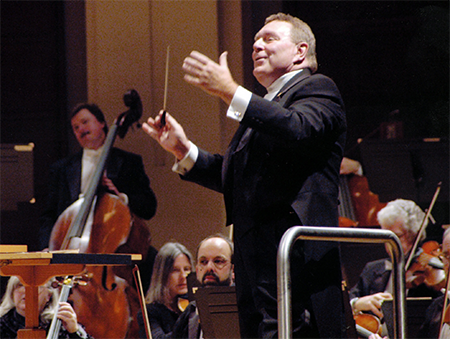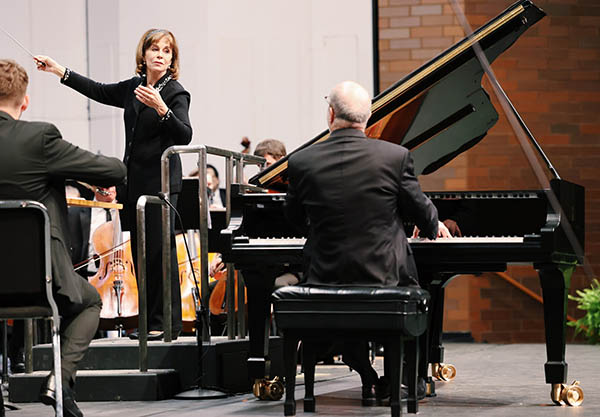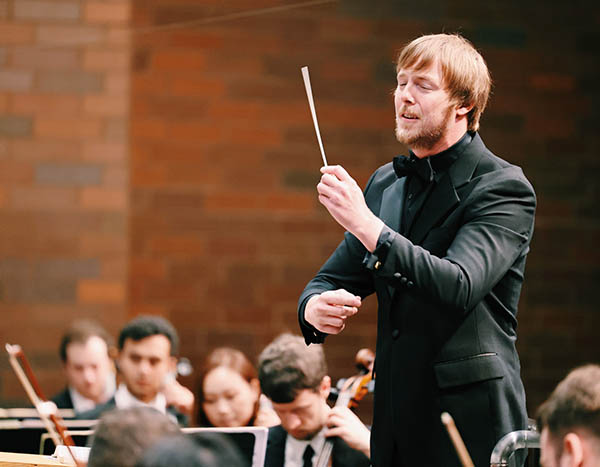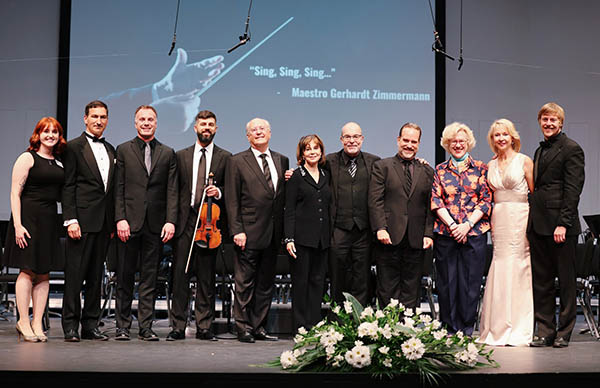by Kevin McLaughlin

Former conducting students and colleagues took turns at the podium, and soloists whose careers Zimmermann had touched also took part in a program of works by Mahler, Brahms, Mozart, and Tchaikovsky, among others.
Possibly the most shining example of Zimmermann’s legacy is the orchestra that he developed and led for 43 years. In an age of peripatetic conductors and short-lived musical directorships, the Canton Symphony Orchestra, an ensemble of ninety mostly young professionals, has remained remarkably excellent and intact over the years.
The seriousness of the occasion was reflected in the many slow and solemn movements chosen. That was balanced by some scattered allegros, one choral work, and family stories at the end, which helped to shed a different light on their subject.
The Adagio from Brahms’ Piano Concerto No. 1 was played exquisitely by Norman Krieger, and the orchestra was assuredly led by JoAnn Falletta. Thoughts of melancholy likely accounted for their more vertical (versus forward-leaning) account.
Mary Verdi-Fletcher introduced a 2015 video of Zimmermann, the CSO, and her Dancing Wheels troupe, a professional company uniting the talents of dancers with and without disabilities. The music was Mahler’s Adagietto from his Fifth Symphony. The power of the original live performance was unfortunately diminished by the hard-to-see video images, but still, gliding wheelchairs in synchronicity with human limbs and the aching beauty of Mahler’s music combined for an astonishing moment of lithesome loveliness.
Conductor John Vincent Russo announced that the Johann Strauss confection Vergnügungszug (“Pleasure Train”) — and similarly, Overture to Fledermaus after intermission — would serve to “lighten the mood.” Though well intentioned, it didn’t quite work, the froth coming across as odd amid all the solemnity. Perhaps a Tombeau de Couperin (serious but light) might have been a better choice.
Falletta returned to lead the last movement from Mahler’s Symphony No. 4, Morgenglocken (“Morning Bells”), with soprano Jacqueline Culpepper as soloist. Culpepper, a professor at Davidson College in North Carolina, and Zimmermann had collaborated “hundreds of times” over a period of thirty years. She sang the words Wir genießen die himmlischen Freuden (“We revel in heavenly pleasures”) with a good amount of childish innocence. Surely the maestro was smiling down.
Soloist Sara Davis Buechner was a real standout in Mozart’s Rondo in A, written as a stand-alone movement for piano and orchestra in 1782 (though possibly for use as an alternative finale for a late concerto). She possesses a diamond-like sense of clarity, but a light touch. Her dialogues with the orchestra were playful and bright. Under Falletta’s direction and Buechner’s example, the orchestra transported themselves to a different century’s grace and elegance.
Another highlight was Wesley Schulz’s plaintive reading of the second movement from Tchaikovsky’s Fifth Symphony, distinguished by Micah Northam’s noble horn solo.
Matthew Jenkins Jaroszewicz stepped up to lead a superb Beethoven’s Seventh Symphony finale. Previously Associate Conductor and now music director designate of the CSO, Jaroszewicz told the story about Zimmermann’s introduction to classical music after auditioning as a freshman trumpet player at Bowling Green State University. The young man was instructed to get himself a record player after he admitted he had none. The record that came with the phonograph? Beethoven’s Seventh.
The Lord Bless You and Keep You, performed by the CSO Chorus and conducted by Douglas Beery, made for a lovely benediction.
The family’s memories completed the concert with heart-tugging anecdotes of “Popo,” whom we all newly appreciated not just as an outstanding conductor and advocate for classical music in Northeast Ohio, but a caring teacher and a loving grandfather, father, and husband.
Published on ClevelandClassical.com September 14, 2023.
Click here for a printable copy of this article






